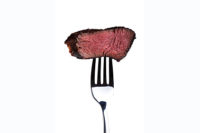Meat Science Review: Managing sodium levels in beef injection brines

 Injection technology allows marinade ingredients — most commonly salt (sodium chloride) and sodium phosphates (SP) — to be dispersed within whole-muscle cuts of meat immediately and evenly.
Injection technology allows marinade ingredients — most commonly salt (sodium chloride) and sodium phosphates (SP) — to be dispersed within whole-muscle cuts of meat immediately and evenly.
With the current focus on public health effects due to excessive sodium consumption, many processing entities are looking to curb their use of sodium-heavy ingredients, a category under which salt (40% Na) and SP (~30% Na, depending on blend) certainly fall. Because of this, sodium-free functional ingredients are of great importance to meat processors and purveyors.
With this in mind, researchers at Oklahoma State University undertook a study with two objectives:
- Develop predictive models that describe how injected beef strip loins (longissimus lumborum) and, subsequently, steaks from those loins, lose fluid at different steps in the process depending on the levels of salt and SP present, and
- Evaluate the effect of a functional beef protein (developed from beef collagen) on fluid retention.
The strip loins were injected to a targeted 10% increase in weight with brines containing salt (0 – 3.6% of brine), SP (0 – 4.5% of brine; Brifisol® 85 Instant) and beef protein (0 or 5%). Statistical tools were utilized to create prediction equations that could estimate yield loss due to the presence/level of the tested ingredients.
The most surprising observation was the disproportionate amount of fluid lost within 30 minutes of injection. Even at maximum levels of salt and SP, 11% of the fluid initially injected is expelled inside of 30 minutes, while only 4% more is predicted to be lost following slicing, overwrap and four days of storage. Halving the ingredient levels lowers the predicted final sodium content by 40%, but doubles the fluid lost immediately following injection.
When the beef collagen is included in the brine, predicted values of fluid loss were lowest when salt or SP were at a maximum level individually. This method also allows for a 40% reduction in sodium content, but instead of an increase in fluid loss, yields are markedly improved, with brine retention at 2-4% after 30 minutes and 12-18% after four days.
The trade-off between sodium reduction and yield is precarious when considering the use of salt and sodium phosphates. Many other factors complicate the decision-making process, and not all processors and retailers place equal importance on these factors. One may prioritize sodium reduction or a clean label and benefit from greater yields by using a product such as beef collagen to replace salt or SP. Another may desire greater display shelf-life or the taste of sodium chloride, making total elimination of salt or SP impractical. The authors have made a workbook available on their Web site that allows use of the equations generated from the study.
The research discussed in this article was conducted at the Food and Agricultural Products Center at Oklahoma State University. The authors are currently with the Seafood Research and Education Center and Department of Food Science at Oregon State University. Contact the authors for more information on the ingredients used in this research.
Looking for a reprint of this article?
From high-res PDFs to custom plaques, order your copy today!






